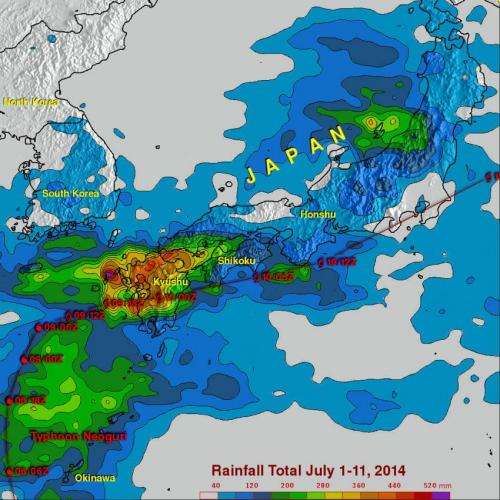A NASA TRMM satellite rainfall analysis from July 1 to 11 showed rainfall totals of over 520 mm (about 20.4 inches) near the western tip of the Japanese island of Kyushu. Neoguri's locations appear in red. Credit: SSAI/NASA, Hal Pierce
The once-powerful Super Typhoon Neoguri weakened to a tropical storm when it dropped heavy rainfall over southern Japan during the week of July 7, 2014. NASA and the Japan Aerospace Exploration Agency's Tropical Rainfall Measuring Mission or TRMM satellite measured that soaking from its orbit in space and data was used to create a maps showing the rainfall totals.
Heavy rainfall from Neoguri fell on land that was already soaked earlier this month by a slow moving seasonal frontal system. Neoguri was reported to have caused up to five deaths and 50 injuries in Japan.
Rainfall from tropical storm Neoguri also caused a large landslide in the town of Nagiso on the main island of Honshu resulting in one death and the destruction of many buildings.
A TRMM Multi-Satellite Precipitation Analysis (TMPA), produced at NASA's Goddard Space Flight Center, Greenbelt, Maryland, combined the rainfall estimates generated by TRMM and other satellites. The analysis showed a near-real time Multi-satellite Precipitation Analysis (TMPA) for the period from July 1 to 11, 2014. The analysis indicated rainfall totals of over 520 mm (about 20.4 inches) near the western tip of the Japanese island of Kyushu. Neoguri's past locations and track are shown with red symbols.
Provided by NASA's Goddard Space Flight Center
























